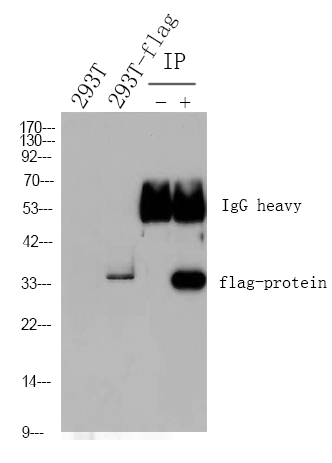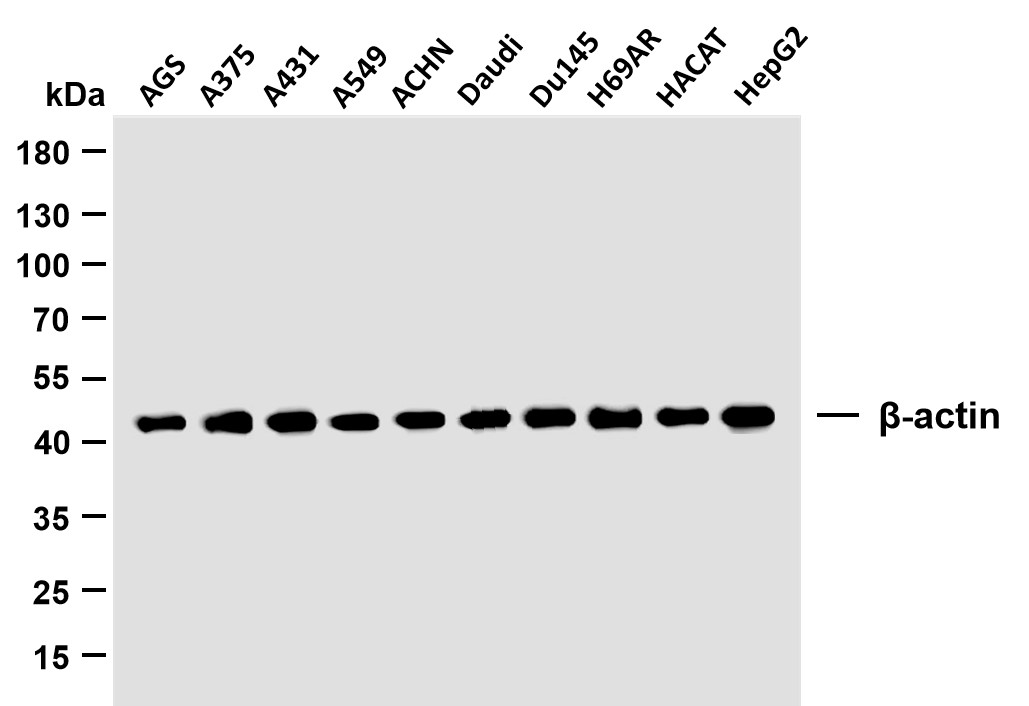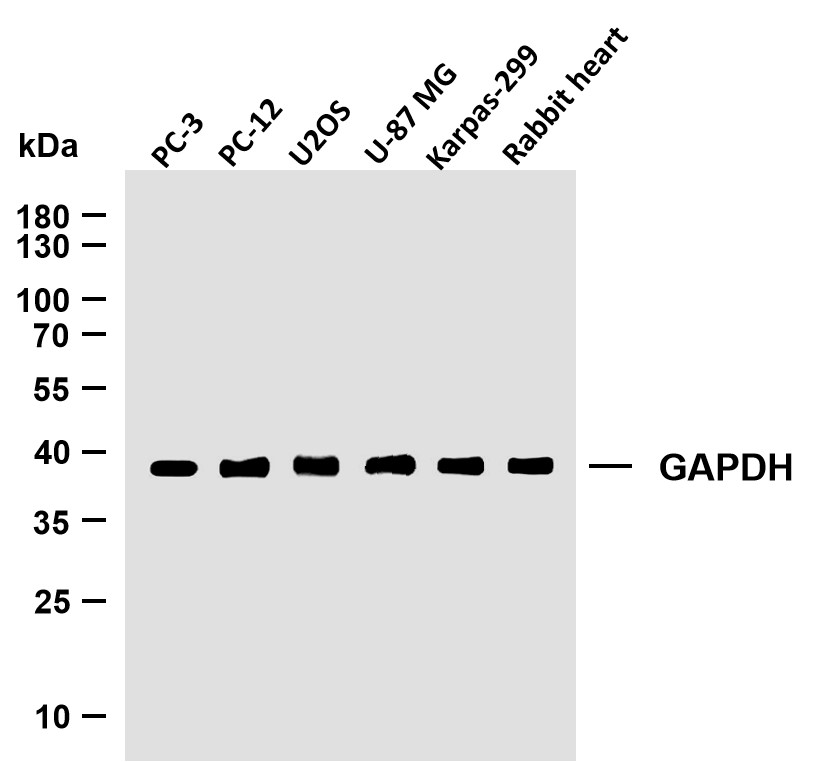
Catalog: YP0963
Size
Price
Status
Qty.
200μL
$600.00
In stock
0
100μL
$340.00
In stock
0
50μL
$190.00
In stock
0
Add to cart


Collected


Collect
Main Information
Target
PKA
Host Species
Rabbit
Reactivity
Human, Mouse, Rat
Applications
IHC, IF, ELISA
MW
41kD (Calculated)
Conjugate/Modification
Phospho
Detailed Information
Recommended Dilution Ratio
IHC 1:100-1:300; ELISA 1:5000; IF 1:50-200
Formulation
Liquid in PBS containing 50% glycerol, 0.5% BSA and 0.02% sodium azide.
Specificity
Phospho-PKAα cat (S338) Polyclonal Antibody detects endogenous levels of PKAα cat protein only when phosphorylated at S338.The name of modified sites may be influenced by many factors, such as species (the modified site was not originally found in human samples) and the change of protein sequence (the previous protein sequence is incomplete, and the protein sequence may be prolonged with the development of protein sequencing technology). When naming, we will use the "numbers" in historical reference to keep the sites consistent with the reports. The antibody binds to the following modification sequence (lowercase letters are modification sites):RVsIN
Purification
The antibody was affinity-purified from rabbit antiserum by affinity-chromatography using epitope-specific immunogen.
Storage
-15°C to -25°C/1 year(Do not lower than -25°C)
Concentration
1 mg/ml
MW(Calculated)
41kD
Modification
Phospho
Clonality
Polyclonal
Isotype
IgG
Related Products
Antigen&Target Information
Immunogen:
Synthesized phospho-peptide around the phosphorylation site of human PKAα cat (phospho Ser338)
show all
Specificity:
Phospho-PKAα cat (S338) Polyclonal Antibody detects endogenous levels of PKAα cat protein only when phosphorylated at S338.The name of modified sites may be influenced by many factors, such as species (the modified site was not originally found in human samples) and the change of protein sequence (the previous protein sequence is incomplete, and the protein sequence may be prolonged with the development of protein sequencing technology). When naming, we will use the "numbers" in historical reference to keep the sites consistent with the reports. The antibody binds to the following modification sequence (lowercase letters are modification sites):RVsIN
show all
Gene Name:
PRKACA
show all
Protein Name:
cAMP-dependent protein kinase catalytic subunit alpha
show all
Other Name:
PRKACA ;
PKACA ;
cAMP-dependent protein kinase catalytic subunit alpha ;
PKA C-alpha
PKACA ;
cAMP-dependent protein kinase catalytic subunit alpha ;
PKA C-alpha
show all
Background:
This gene encodes one of the catalytic subunits of protein kinase A, which exists as a tetrameric holoenzyme with two regulatory subunits and two catalytic subunits, in its inactive form. cAMP causes the dissociation of the inactive holoenzyme into a dimer of regulatory subunits bound to four cAMP and two free monomeric catalytic subunits. Four different regulatory subunits and three catalytic subunits have been identified in humans. cAMP-dependent phosphorylation of proteins by protein kinase A is important to many cellular processes, including differentiation, proliferation, and apoptosis. Constitutive activation of this gene caused either by somatic mutations, or genomic duplications of regions that include this gene, have been associated with hyperplasias and adenomas of the adrenal cortex and are linked to corticotropin-independent Cushing's syndrome. Altern
show all
Function:
Catalytic activity:ATP + a protein = ADP + a phosphoprotein.,enzyme regulation:Activated by cAMP.,Function:Phosphorylates a large number of substrates in the cytoplasm and the nucleus.,PTM:Asn-3 is partially deaminated to Asp giving rise to 2 major isoelectric variants, called CB and CA respectively.,similarity:Belongs to the protein kinase superfamily.,similarity:Belongs to the protein kinase superfamily. AGC Ser/Thr protein kinase family. cAMP subfamily.,similarity:Contains 1 AGC-kinase C-terminal domain.,similarity:Contains 1 protein kinase domain.,subcellular location:Translocates into the nucleus (monomeric catalytic subunit) (By similarity). The inactive holoenzyme is found in the cytoplasm.,subunit:A number of inactive tetrameric holoenzymes are produced by the combination of homo- or heterodimers of the different regulatory subunits associated with two catalytic subunits. cAMP causes the dissociation of the inactive holoenzyme into a dimer of regulatory subunits bound to four cAMP and two free monomeric catalytic subunits.,tissue specificity:Isoform 2 is sperm specific.,
show all
Cellular Localization:
Cytoplasm. Cell membrane. Nucleus . Mitochondrion . Membrane ; Lipid-anchor . Translocates into the nucleus (monomeric catalytic subunit). The inactive holoenzyme is found in the cytoplasm. Distributed throughout the cytoplasm in meiotically incompetent oocytes. Associated to mitochondrion as meiotic competence is acquired. Aggregates around the germinal vesicles (GV) at the immature GV stage oocytes (By similarity). Colocalizes with HSF1 in nuclear stress bodies (nSBs) upon heat shock (PubMed:21085490). .; [Isoform 2]: Cell projection, cilium, flagellum . Cytoplasmic vesicle, secretory vesicle, acrosome . Expressed in the midpiece region of the sperm flagellum (PubMed:10906071). Colocalizes with MROH2B and TCP11 on the acrosome and tail regions in round spermatids and spermatozoa regardless of the capacitation status of the sperm (By similarity). .
show all
Tissue Expression:
Isoform 1 is ubiquitous. Isoform 2 is sperm-specific and is enriched in pachytene spermatocytes but is not detected in round spermatids.
show all
Research Areas:
>>Endocrine resistance ;
>>MAPK signaling pathway ;
>>Ras signaling pathway ;
>>Calcium signaling pathway ;
>>cAMP signaling pathway ;
>>Chemokine signaling pathway ;
>>Oocyte meiosis ;
>>Autophagy - animal ;
>>Longevity regulating pathway ;
>>Longevity regulating pathway - multiple species ;
>>Adrenergic signaling in cardiomyocytes ;
>>Vascular smooth muscle contraction ;
>>Wnt signaling pathway ;
>>Hedgehog signaling pathway ;
>>Apelin signaling pathway ;
>>Tight junction ;
>>Gap junction ;
>>Platelet activation ;
>>Circadian entrainment ;
>>Thermogenesis ;
>>Long-term potentiation ;
>>Retrograde endocannabinoid signaling ;
>>Glutamatergic synapse ;
>>Cholinergic synapse ;
>>Serotonergic synapse ;
>>GABAergic synapse ;
>>Dopaminergic synapse ;
>>Olfactory transduction ;
>>Taste transduction ;
>>Inflammatory mediator regulation of TRP channels ;
>>Insulin signaling pathway ;
>>Insulin secretion ;
>>GnRH signaling pathway ;
>>Ovarian steroidogenesis ;
>>Progesterone-mediated oocyte maturation ;
>>Estrogen signaling pathway ;
>>Melanogenesis ;
>>Thyroid hormone synthesis ;
>>Thyroid hormone signaling pathway ;
>>Oxytocin signaling pathway ;
>>Glucagon signaling pathway ;
>>Regulation of lipolysis in adipocytes ;
>>Renin secretion ;
>>Aldosterone synthesis and secretion ;
>>Relaxin signaling pathway ;
>>Cortisol synthesis and secretion ;
>>Parathyroid hormone synthesis, secretion and action ;
>>Cushing syndrome ;
>>Growth hormone synthesis, secretion and action ;
>>Endocrine and other factor-regulated calcium reabsorption ;
>>Vasopressin-regulated water reabsorption ;
>>Salivary secretion ;
>>Gastric acid secretion ;
>>Bile secretion ;
>>Parkinson disease ;
>>Prion disease ;
>>Cocaine addiction ;
>>Amphetamine addiction ;
>>Morphine addiction ;
>>Alcoholism ;
>>Vibrio cholerae infection ;
>>Amoebiasis ;
>>Human cytomegalovirus infection ;
>>Human papillomavirus infection ;
>>Human T-cell leukemia virus 1 infection ;
>>Pathways in cancer ;
>>Viral carcinogenesis ;
>>Proteoglycans in cancer ;
>>Chemical carcinogenesis - receptor activation ;
>>Dilated cardiomyopathy
>>MAPK signaling pathway ;
>>Ras signaling pathway ;
>>Calcium signaling pathway ;
>>cAMP signaling pathway ;
>>Chemokine signaling pathway ;
>>Oocyte meiosis ;
>>Autophagy - animal ;
>>Longevity regulating pathway ;
>>Longevity regulating pathway - multiple species ;
>>Adrenergic signaling in cardiomyocytes ;
>>Vascular smooth muscle contraction ;
>>Wnt signaling pathway ;
>>Hedgehog signaling pathway ;
>>Apelin signaling pathway ;
>>Tight junction ;
>>Gap junction ;
>>Platelet activation ;
>>Circadian entrainment ;
>>Thermogenesis ;
>>Long-term potentiation ;
>>Retrograde endocannabinoid signaling ;
>>Glutamatergic synapse ;
>>Cholinergic synapse ;
>>Serotonergic synapse ;
>>GABAergic synapse ;
>>Dopaminergic synapse ;
>>Olfactory transduction ;
>>Taste transduction ;
>>Inflammatory mediator regulation of TRP channels ;
>>Insulin signaling pathway ;
>>Insulin secretion ;
>>GnRH signaling pathway ;
>>Ovarian steroidogenesis ;
>>Progesterone-mediated oocyte maturation ;
>>Estrogen signaling pathway ;
>>Melanogenesis ;
>>Thyroid hormone synthesis ;
>>Thyroid hormone signaling pathway ;
>>Oxytocin signaling pathway ;
>>Glucagon signaling pathway ;
>>Regulation of lipolysis in adipocytes ;
>>Renin secretion ;
>>Aldosterone synthesis and secretion ;
>>Relaxin signaling pathway ;
>>Cortisol synthesis and secretion ;
>>Parathyroid hormone synthesis, secretion and action ;
>>Cushing syndrome ;
>>Growth hormone synthesis, secretion and action ;
>>Endocrine and other factor-regulated calcium reabsorption ;
>>Vasopressin-regulated water reabsorption ;
>>Salivary secretion ;
>>Gastric acid secretion ;
>>Bile secretion ;
>>Parkinson disease ;
>>Prion disease ;
>>Cocaine addiction ;
>>Amphetamine addiction ;
>>Morphine addiction ;
>>Alcoholism ;
>>Vibrio cholerae infection ;
>>Amoebiasis ;
>>Human cytomegalovirus infection ;
>>Human papillomavirus infection ;
>>Human T-cell leukemia virus 1 infection ;
>>Pathways in cancer ;
>>Viral carcinogenesis ;
>>Proteoglycans in cancer ;
>>Chemical carcinogenesis - receptor activation ;
>>Dilated cardiomyopathy
show all
Signaling Pathway
Cellular Processes >> Transport and catabolism >> Autophagy - animal
Cellular Processes >> Cellular community - eukaryotes >> Tight junction
Cellular Processes >> Cellular community - eukaryotes >> Gap junction
Organismal Systems >> Immune system >> Platelet activation
Organismal Systems >> Immune system >> Chemokine signaling pathway
Organismal Systems >> Endocrine system >> Insulin secretion
Organismal Systems >> Endocrine system >> Insulin signaling pathway
Organismal Systems >> Endocrine system >> Glucagon signaling pathway
Organismal Systems >> Endocrine system >> GnRH signaling pathway
Organismal Systems >> Endocrine system >> Estrogen signaling pathway
Organismal Systems >> Endocrine system >> Oxytocin signaling pathway
Organismal Systems >> Endocrine system >> Relaxin signaling pathway
Organismal Systems >> Endocrine system >> Growth hormone synthesis, secretion and action
Organismal Systems >> Endocrine system >> Thyroid hormone signaling pathway
Organismal Systems >> Endocrine system >> Aldosterone synthesis and secretion
Organismal Systems >> Circulatory system >> Adrenergic signaling in cardiomyocytes
Organismal Systems >> Circulatory system >> Vascular smooth muscle contraction
Organismal Systems >> Nervous system >> Glutamatergic synapse
Organismal Systems >> Nervous system >> Cholinergic synapse
Organismal Systems >> Nervous system >> Dopaminergic synapse
Organismal Systems >> Sensory system >> Inflammatory mediator regulation of TRP channels
Organismal Systems >> Aging >> Longevity regulating pathway
Organismal Systems >> Aging >> Longevity regulating pathway - multiple species
Human Diseases >> Cancer: overview >> Pathways in cancer
Human Diseases >> Neurodegenerative disease >> Parkinson disease
Human Diseases >> Neurodegenerative disease >> Prion disease
Environmental Information Processing >> Signal transduction >> MAPK signaling pathway
Environmental Information Processing >> Signal transduction >> Ras signaling pathway
Environmental Information Processing >> Signal transduction >> Wnt signaling pathway
Environmental Information Processing >> Signal transduction >> Hedgehog signaling pathway
Environmental Information Processing >> Signal transduction >> Apelin signaling pathway
Environmental Information Processing >> Signal transduction >> Calcium signaling pathway
Environmental Information Processing >> Signal transduction >> cAMP signaling pathway
Reference Citation({{totalcount}})
Catalog: YP0963
Size
Price
Status
Qty.
200μL
$600.00
In stock
0
100μL
$340.00
In stock
0
50μL
$190.00
In stock
0
Add to cart


Collected


Collect
Recently Viewed Products
Clear allPRODUCTS
CUSTOMIZED
ABOUT US
Toggle night Mode
{{pinfoXq.title || ''}}
Catalog: {{pinfoXq.catalog || ''}}
Filter:
All
{{item.name}}
{{pinfo.title}}
-{{pinfo.catalog}}
Main Information
Target
{{pinfo.target}}
Reactivity
{{pinfo.react}}
Applications
{{pinfo.applicat}}
Conjugate/Modification
{{pinfo.coupling}}/{{pinfo.modific}}
MW (kDa)
{{pinfo.mwcalc}}
Host Species
{{pinfo.hostspec}}
Isotype
{{pinfo.isotype}}
Product {{index}}/{{pcount}}
Prev
Next
{{pvTitle}}
Scroll wheel zooms the picture
{{pvDescr}}


















